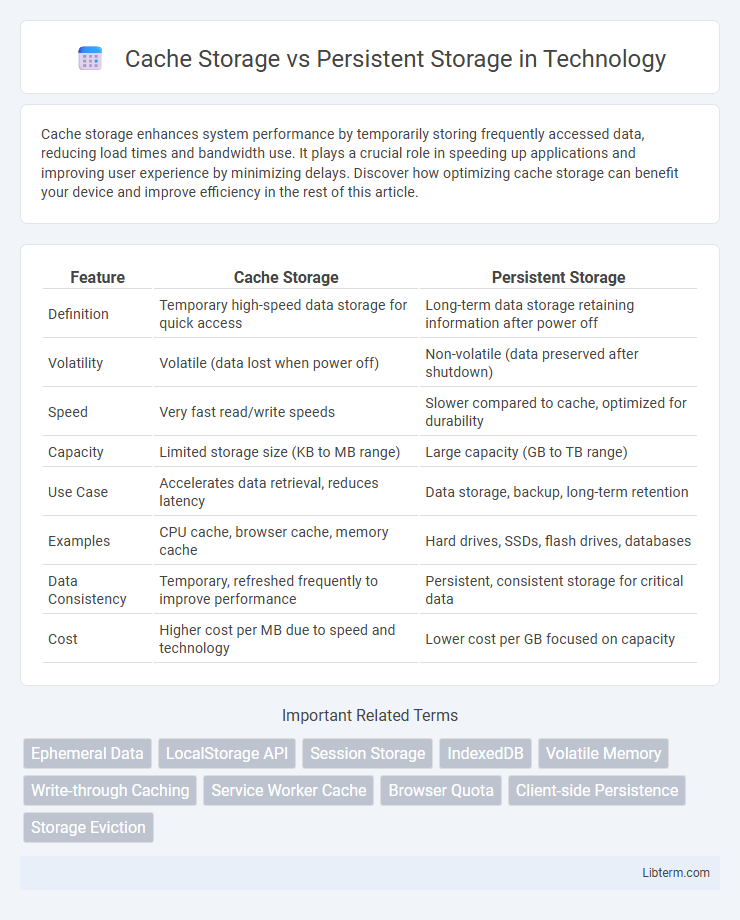Cache storage enhances system performance by temporarily storing frequently accessed data, reducing load times and bandwidth use. It plays a crucial role in speeding up applications and improving user experience by minimizing delays. Discover how optimizing cache storage can benefit your device and improve efficiency in the rest of this article.
Table of Comparison
| Feature | Cache Storage | Persistent Storage |
|---|---|---|
| Definition | Temporary high-speed data storage for quick access | Long-term data storage retaining information after power off |
| Volatility | Volatile (data lost when power off) | Non-volatile (data preserved after shutdown) |
| Speed | Very fast read/write speeds | Slower compared to cache, optimized for durability |
| Capacity | Limited storage size (KB to MB range) | Large capacity (GB to TB range) |
| Use Case | Accelerates data retrieval, reduces latency | Data storage, backup, long-term retention |
| Examples | CPU cache, browser cache, memory cache | Hard drives, SSDs, flash drives, databases |
| Data Consistency | Temporary, refreshed frequently to improve performance | Persistent, consistent storage for critical data |
| Cost | Higher cost per MB due to speed and technology | Lower cost per GB focused on capacity |
Introduction to Cache Storage and Persistent Storage
Cache storage temporarily holds frequently accessed data to accelerate retrieval and improve system performance, using fast memory like RAM or SSDs. Persistent storage maintains data permanently on non-volatile media such as hard drives or flash storage, ensuring data remains intact after power loss. Understanding the difference between cache storage's volatility and persistent storage's durability is crucial for optimizing data management in computing systems.
Key Differences Between Cache and Persistent Storage
Cache storage is a high-speed memory layer designed to temporarily store frequently accessed data for rapid retrieval, significantly improving system performance. Persistent storage, such as SSDs or HDDs, retains data permanently, ensuring durability even during power loss or system shutdowns. The key difference lies in cache's volatility and speed optimization versus persistent storage's focus on data permanence and capacity.
How Cache Storage Works
Cache storage temporarily holds frequently accessed data to speed up retrieval by reducing latency and minimizing access to slower persistent storage like SSDs or HDDs. It operates using high-speed memory such as RAM, storing copies of data from persistent storage to quickly serve future requests without repeatedly fetching the original data. Cache storage employs mechanisms like cache lines, hits, and misses to optimize data retrieval efficiency and maintain consistency with underlying persistent storage.
How Persistent Storage Works
Persistent storage refers to data storage that retains information even after the device is powered off, utilizing hardware such as hard drives, solid-state drives, or non-volatile memory to save data permanently. It works by writing data in fixed or variable-sized blocks that remain intact until explicitly deleted or overwritten, enabling long-term data retention essential for applications, operating systems, and user files. Unlike cache storage, which temporarily holds data for quick access, persistent storage ensures durability and reliability, supporting file systems, databases, and backup solutions.
Use Cases for Cache Storage
Cache storage optimizes performance by temporarily storing frequently accessed data, reducing latency and improving application responsiveness in web browsers, mobile apps, and server-side systems. Common use cases include speeding up page load times by caching images and scripts, enabling offline access to cached content in progressive web apps (PWAs), and enhancing API response times in distributed systems. Cache storage is ideal for data that changes frequently and requires quick retrieval, whereas persistent storage is suited for long-term data retention and complex data transactions.
Use Cases for Persistent Storage
Persistent storage is essential for applications requiring data retention beyond a single session, such as database management systems, user preference saving, and file system storage. It supports long-term data integrity and durability, making it ideal for backup systems, transaction logs, and content management platforms. Unlike cache storage, persistent storage ensures data is not lost during power failures or system reboots.
Performance Impact: Cache vs Persistent Storage
Cache storage significantly enhances application performance by providing faster data access through temporary, high-speed memory buffers that reduce latency compared to persistent storage. Persistent storage, while essential for long-term data retention, involves slower read/write speeds due to disk I/O or network access, impacting response times in performance-critical operations. Utilizing cache storage strategically minimizes the frequency of expensive persistent storage interactions, resulting in improved data retrieval speeds and overall system efficiency.
Data Consistency and Reliability Comparison
Cache storage offers faster data retrieval by temporarily storing frequently accessed information, but it may suffer from data inconsistency due to its volatile nature and limited update mechanisms. Persistent storage ensures long-term data durability and higher reliability through non-volatile memory systems like SSDs or HDDs, maintaining data integrity even during power failures. For applications requiring strict data consistency and durability, persistent storage is preferred, while cache storage is suited for performance optimization with tolerable consistency trade-offs.
Security Considerations in Storage Options
Cache storage offers faster access speeds but typically lacks robust encryption, increasing vulnerability to unauthorized data retrieval. Persistent storage systems often implement advanced security measures such as encryption at rest, access controls, and regular integrity checks to protect sensitive information. Choosing between cache and persistent storage requires evaluating the balance between performance needs and stringent security requirements to prevent data breaches.
Choosing the Right Storage Solution
Cache storage offers rapid data access with limited capacity, ideal for temporary storage of frequently accessed information, while persistent storage provides durable data retention suitable for long-term retention and complex data management. Evaluating application requirements such as speed, data size, and durability is essential to selecting between cache and persistent storage solutions. Optimal storage strategies often combine both, leveraging cache for performance and persistent storage for reliability.
Cache Storage Infographic

 libterm.com
libterm.com